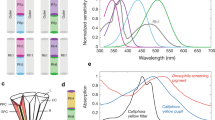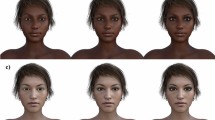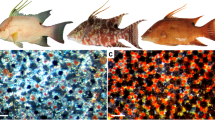Abstract
GREGORY1 has viewed the evolution of the visual sense as a “hen and egg” problem involving eyes and brains. It is only reasonable to infer that eyes and brains have mutually exerted evolutionary pressures, but setting aside the somewhat arbitrary distinction between the two, because some eyes incorporate part of the integrative mechanism, partnership between an eye (whether of the simple or compound type) and an integrative apparatus is not the only prescription for a successful photosensory system.
This is a preview of subscription content, access via your institution
Access options
Subscribe to this journal
Receive 51 print issues and online access
$199.00 per year
only $3.90 per issue
Buy this article
- Purchase on Springer Link
- Instant access to full article PDF
Prices may be subject to local taxes which are calculated during checkout
Similar content being viewed by others
References
Gregory, R. L., Nature, 213, 369 (1967).
Nagel, W. A., Der Lichtsinn augenloser Tiere (Fischer, Jena, 1896).
Millott, N., Endeavour, 16, 19 (1957).
Steven, D. M., Biol. Rev., 38, 204 (1963).
Eakin, R. M., Cold Spring Harbor Symp. Quant. Biol., 30, 363 (1965).
Millott, N., J. Exp. Biol., 33, 508 (1956).
Viaud, G., Experientia, 4, 81 (1948).
Yoshida, M., in Physiology of Echinodermata (edit. by Boolootian, R. A.), 435 (Interscience, New York, 1966).
Kennedy, D., J. Gen. Physiol., 44, 277 (1960).
Millott, N., in Light as an Ecological Factor (edit. by Bainbridge, R., Evans, G. C., and Rackham, O.), 265 (Blackwell, Oxford, 1966).
Yoshida, M., and Millott, N., Experientia, 15, 13 (1959).
Takahashi, K., Nature, 201, 1343 (1964).
Hama, K., Anat. Rec., 140, 329 (1961).
Yoshida, M., and Millott, N., J. Exp. Biol., 37, 390 (1960).
Arvanitaki, A., and Chalazonitis, N., in Nervous Inhibition, 194 (Pergamon Press, Oxford, 1961).
Young, J. Z., J. Exp. Biol., 12, 229 (1935).
Millott, N., and Yoshida, M., J. Exp. Biol., 37, 363 (1960).
Millott, N., and Yoshida, M., J. Exp. Biol., 37, 376 (1960).
Millott, N., and Takahashi, K., Phil. Trans. Roy. Soc. London, B, 246, 437 (1963).
Hartline, H. K., Ratliff, F., and Miller, W. H., in Nervous Inhibition, 241 (Pergamon Press, Oxford, 1961).
Cornman, I., Nature, 200, 88 (1963).
Bullock, T. H., Amer. Zool., 5, 545 (1965).
Kennedy, D., Sci. Amer., 209, 122 (1963).
Author information
Authors and Affiliations
Rights and permissions
About this article
Cite this article
MILLOTT, N. Dermal Photosensitivity and the “Hen and Egg” Problem. Nature 215, 768–769 (1967). https://doi.org/10.1038/215768a0
Received:
Revised:
Published:
Issue Date:
DOI: https://doi.org/10.1038/215768a0
Comments
By submitting a comment you agree to abide by our Terms and Community Guidelines. If you find something abusive or that does not comply with our terms or guidelines please flag it as inappropriate.



